Input interpretation

H_2S hydrogen sulfide + CuCl_2 copper(II) chloride ⟶ HCl hydrogen chloride + CuS cupric sulfide
Balanced equation
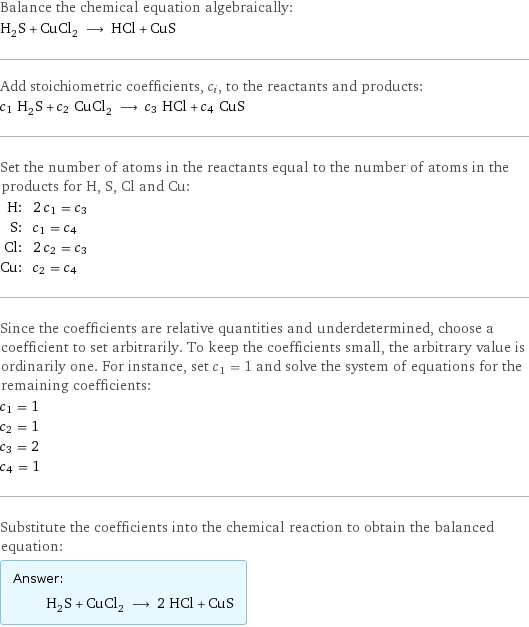
Balance the chemical equation algebraically: H_2S + CuCl_2 ⟶ HCl + CuS Add stoichiometric coefficients, c_i, to the reactants and products: c_1 H_2S + c_2 CuCl_2 ⟶ c_3 HCl + c_4 CuS Set the number of atoms in the reactants equal to the number of atoms in the products for H, S, Cl and Cu: H: | 2 c_1 = c_3 S: | c_1 = c_4 Cl: | 2 c_2 = c_3 Cu: | c_2 = c_4 Since the coefficients are relative quantities and underdetermined, choose a coefficient to set arbitrarily. To keep the coefficients small, the arbitrary value is ordinarily one. For instance, set c_1 = 1 and solve the system of equations for the remaining coefficients: c_1 = 1 c_2 = 1 c_3 = 2 c_4 = 1 Substitute the coefficients into the chemical reaction to obtain the balanced equation: Answer: | | H_2S + CuCl_2 ⟶ 2 HCl + CuS
Structures

+ ⟶ +
Names

hydrogen sulfide + copper(II) chloride ⟶ hydrogen chloride + cupric sulfide
Reaction thermodynamics
Enthalpy
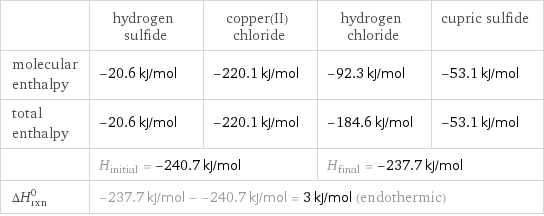
| hydrogen sulfide | copper(II) chloride | hydrogen chloride | cupric sulfide molecular enthalpy | -20.6 kJ/mol | -220.1 kJ/mol | -92.3 kJ/mol | -53.1 kJ/mol total enthalpy | -20.6 kJ/mol | -220.1 kJ/mol | -184.6 kJ/mol | -53.1 kJ/mol | H_initial = -240.7 kJ/mol | | H_final = -237.7 kJ/mol | ΔH_rxn^0 | -237.7 kJ/mol - -240.7 kJ/mol = 3 kJ/mol (endothermic) | | |
Gibbs free energy
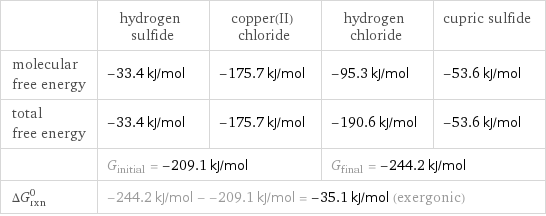
| hydrogen sulfide | copper(II) chloride | hydrogen chloride | cupric sulfide molecular free energy | -33.4 kJ/mol | -175.7 kJ/mol | -95.3 kJ/mol | -53.6 kJ/mol total free energy | -33.4 kJ/mol | -175.7 kJ/mol | -190.6 kJ/mol | -53.6 kJ/mol | G_initial = -209.1 kJ/mol | | G_final = -244.2 kJ/mol | ΔG_rxn^0 | -244.2 kJ/mol - -209.1 kJ/mol = -35.1 kJ/mol (exergonic) | | |
Equilibrium constant
![Construct the equilibrium constant, K, expression for: H_2S + CuCl_2 ⟶ HCl + CuS Plan: • Balance the chemical equation. • Determine the stoichiometric numbers. • Assemble the activity expression for each chemical species. • Use the activity expressions to build the equilibrium constant expression. Write the balanced chemical equation: H_2S + CuCl_2 ⟶ 2 HCl + CuS Assign stoichiometric numbers, ν_i, using the stoichiometric coefficients, c_i, from the balanced chemical equation in the following manner: ν_i = -c_i for reactants and ν_i = c_i for products: chemical species | c_i | ν_i H_2S | 1 | -1 CuCl_2 | 1 | -1 HCl | 2 | 2 CuS | 1 | 1 Assemble the activity expressions accounting for the state of matter and ν_i: chemical species | c_i | ν_i | activity expression H_2S | 1 | -1 | ([H2S])^(-1) CuCl_2 | 1 | -1 | ([CuCl2])^(-1) HCl | 2 | 2 | ([HCl])^2 CuS | 1 | 1 | [CuS] The equilibrium constant symbol in the concentration basis is: K_c Mulitply the activity expressions to arrive at the K_c expression: Answer: | | K_c = ([H2S])^(-1) ([CuCl2])^(-1) ([HCl])^2 [CuS] = (([HCl])^2 [CuS])/([H2S] [CuCl2])](../image_source/d0575c9cc16de09901a4302871ff8799.png)
Construct the equilibrium constant, K, expression for: H_2S + CuCl_2 ⟶ HCl + CuS Plan: • Balance the chemical equation. • Determine the stoichiometric numbers. • Assemble the activity expression for each chemical species. • Use the activity expressions to build the equilibrium constant expression. Write the balanced chemical equation: H_2S + CuCl_2 ⟶ 2 HCl + CuS Assign stoichiometric numbers, ν_i, using the stoichiometric coefficients, c_i, from the balanced chemical equation in the following manner: ν_i = -c_i for reactants and ν_i = c_i for products: chemical species | c_i | ν_i H_2S | 1 | -1 CuCl_2 | 1 | -1 HCl | 2 | 2 CuS | 1 | 1 Assemble the activity expressions accounting for the state of matter and ν_i: chemical species | c_i | ν_i | activity expression H_2S | 1 | -1 | ([H2S])^(-1) CuCl_2 | 1 | -1 | ([CuCl2])^(-1) HCl | 2 | 2 | ([HCl])^2 CuS | 1 | 1 | [CuS] The equilibrium constant symbol in the concentration basis is: K_c Mulitply the activity expressions to arrive at the K_c expression: Answer: | | K_c = ([H2S])^(-1) ([CuCl2])^(-1) ([HCl])^2 [CuS] = (([HCl])^2 [CuS])/([H2S] [CuCl2])
Rate of reaction
![Construct the rate of reaction expression for: H_2S + CuCl_2 ⟶ HCl + CuS Plan: • Balance the chemical equation. • Determine the stoichiometric numbers. • Assemble the rate term for each chemical species. • Write the rate of reaction expression. Write the balanced chemical equation: H_2S + CuCl_2 ⟶ 2 HCl + CuS Assign stoichiometric numbers, ν_i, using the stoichiometric coefficients, c_i, from the balanced chemical equation in the following manner: ν_i = -c_i for reactants and ν_i = c_i for products: chemical species | c_i | ν_i H_2S | 1 | -1 CuCl_2 | 1 | -1 HCl | 2 | 2 CuS | 1 | 1 The rate term for each chemical species, B_i, is 1/ν_i(Δ[B_i])/(Δt) where [B_i] is the amount concentration and t is time: chemical species | c_i | ν_i | rate term H_2S | 1 | -1 | -(Δ[H2S])/(Δt) CuCl_2 | 1 | -1 | -(Δ[CuCl2])/(Δt) HCl | 2 | 2 | 1/2 (Δ[HCl])/(Δt) CuS | 1 | 1 | (Δ[CuS])/(Δt) (for infinitesimal rate of change, replace Δ with d) Set the rate terms equal to each other to arrive at the rate expression: Answer: | | rate = -(Δ[H2S])/(Δt) = -(Δ[CuCl2])/(Δt) = 1/2 (Δ[HCl])/(Δt) = (Δ[CuS])/(Δt) (assuming constant volume and no accumulation of intermediates or side products)](../image_source/f62407fb6f2be9085a9695edbe71d709.png)
Construct the rate of reaction expression for: H_2S + CuCl_2 ⟶ HCl + CuS Plan: • Balance the chemical equation. • Determine the stoichiometric numbers. • Assemble the rate term for each chemical species. • Write the rate of reaction expression. Write the balanced chemical equation: H_2S + CuCl_2 ⟶ 2 HCl + CuS Assign stoichiometric numbers, ν_i, using the stoichiometric coefficients, c_i, from the balanced chemical equation in the following manner: ν_i = -c_i for reactants and ν_i = c_i for products: chemical species | c_i | ν_i H_2S | 1 | -1 CuCl_2 | 1 | -1 HCl | 2 | 2 CuS | 1 | 1 The rate term for each chemical species, B_i, is 1/ν_i(Δ[B_i])/(Δt) where [B_i] is the amount concentration and t is time: chemical species | c_i | ν_i | rate term H_2S | 1 | -1 | -(Δ[H2S])/(Δt) CuCl_2 | 1 | -1 | -(Δ[CuCl2])/(Δt) HCl | 2 | 2 | 1/2 (Δ[HCl])/(Δt) CuS | 1 | 1 | (Δ[CuS])/(Δt) (for infinitesimal rate of change, replace Δ with d) Set the rate terms equal to each other to arrive at the rate expression: Answer: | | rate = -(Δ[H2S])/(Δt) = -(Δ[CuCl2])/(Δt) = 1/2 (Δ[HCl])/(Δt) = (Δ[CuS])/(Δt) (assuming constant volume and no accumulation of intermediates or side products)
Chemical names and formulas
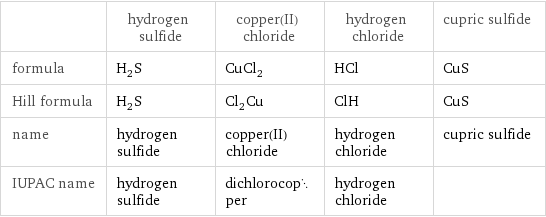
| hydrogen sulfide | copper(II) chloride | hydrogen chloride | cupric sulfide formula | H_2S | CuCl_2 | HCl | CuS Hill formula | H_2S | Cl_2Cu | ClH | CuS name | hydrogen sulfide | copper(II) chloride | hydrogen chloride | cupric sulfide IUPAC name | hydrogen sulfide | dichlorocopper | hydrogen chloride |
Substance properties
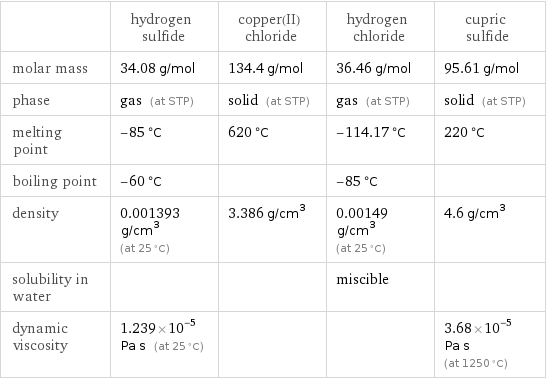
| hydrogen sulfide | copper(II) chloride | hydrogen chloride | cupric sulfide molar mass | 34.08 g/mol | 134.4 g/mol | 36.46 g/mol | 95.61 g/mol phase | gas (at STP) | solid (at STP) | gas (at STP) | solid (at STP) melting point | -85 °C | 620 °C | -114.17 °C | 220 °C boiling point | -60 °C | | -85 °C | density | 0.001393 g/cm^3 (at 25 °C) | 3.386 g/cm^3 | 0.00149 g/cm^3 (at 25 °C) | 4.6 g/cm^3 solubility in water | | | miscible | dynamic viscosity | 1.239×10^-5 Pa s (at 25 °C) | | | 3.68×10^-5 Pa s (at 1250 °C)
Units
